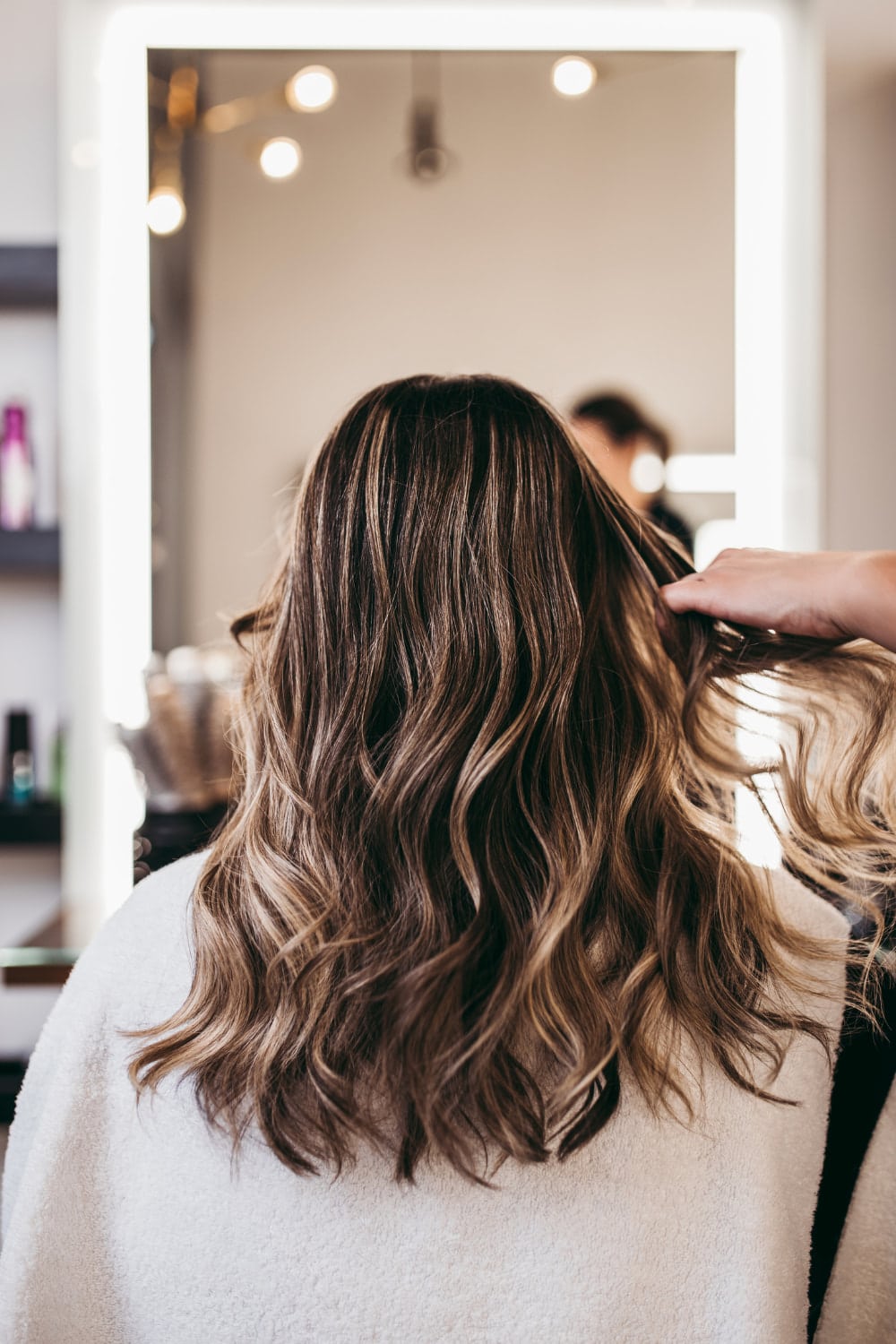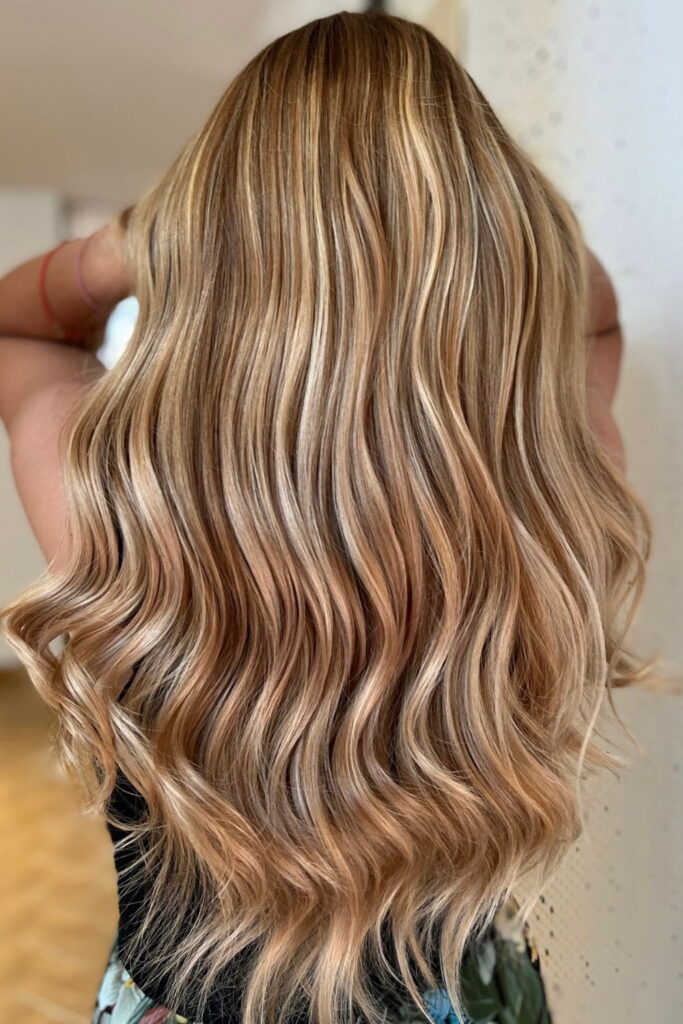
Balayage VS Highlights: the two main techniques for achieving your favorite blond crown. Many think they are the same, and even if the outcome seems similar, they are executed differently.
Are you looking to venture into the universe of the blonds but get confused by all the different terms? Balayage, ombré, highlights, or babylights? The options are endless, so which one should you choose?
Worry not! I am here to explain the difference between balayage and highlights and all your other burning questions.
I will start by explaining what balayage and highlights are and move on to their differences. So, let’s get this article started!
What Is Balayage?
Balayage is a popular hair coloring technique that has taken the beauty world by storm! The word “balayage” is derived from the French word for “sweeping” or “painting,” and it’s an accurate description of the technique.
The Technique
Balayage is a freehand coloring method in which the stylist applies color to the hair’s surface in sweeping motions, creating a natural-looking, sun-kissed effect.
The outcome of balayage is soft, subtle transitions between shades. The light color is subtle at the top of the hair and thickens at the ends, resulting in a beautiful, lived-in look that requires less maintenance than other coloring methods.
Who Can Try Balayage?
Balayage is versatile and can be used on all hair types and colors, making it an excellent option for anyone looking to switch up their hair color.
It’s also an excellent option for those who want a low-maintenance hair color that still looks beautiful and vibrant.
What Are The Different Types Of Balayage?
There are variations of the original balayage technique used to create different outcomes. For example, you can play it safe with micro balayage or make a bold (blond) statement with foilayage.
Each type of balayage produces a unique, low-maintenance outcome that can help you achieve your hair goals. So, what are the different types of balayage?
- Foilayage: This method combines freehand with the use of foils. The foils are used to isolate each section of hair, allowing the color to develop more intensively. It is perfect for those who want more defined, dramatic locks.
- Micro balayage: This is a gentler variation that uses smaller sections of hair and a more natural color for a more delicate sun-kissed look.
- Ombré balayage: It combines the two famous techniques involving darker roots that gradually fade into lighter ends.


What Are Highlights?
Highlights are an all-time classic technique used to create a multidimensional look ranging from subtle and natural to bold and dramatic.
The Technique
There are several takes on the technique for highlights, but the traditional one uses foils. Highlights are a hair coloring technique that involves separating sections of hair, applying bleach or hair dye, and wrapping them in foil to create lighter pieces.
Highlights create a uniform finished look from crown to end. This creates a brightening effect that adds depth and texture and creates a more sophisticated look.
The level of maintenance required for highlights depends on the individual’s hair type and the desired level of contrast. Regular touch-ups may be needed to maintain the look, while proper hair care is a must.
Who Can Try Highlights?
Highlights are a versatile and customizable technique that can add dimension and interest to any hairstyle. Also, highlights don’t have to be blond, making them suitable for brightening up any hair color.
However, they may be an immense pain for my fellows out there who hate often and extended visits to the saloon.
What Are The Different Types Of Highlights?
Did you think that you learned about highlights and that’s all? Well, there are variations of the classic technique here as well. Your hair stylist will use the one that compliments your hair the most.
- Babylights: In this highlighting technique, the colorist applies ultra-fine highlights throughout the hair, mimicking the natural highlights seen on children’s hair. The result is a subtle, natural-looking effect that blends seamlessly with the base color.
- Lowlights: This technique involves adding darker shades of color to select strands of hair. It is particularly useful for those with naturally light hair who want to add some contrast and texture to their locks.


What Is The Difference Between Balayage And Highlights?
And now that you have become an expert in both techniques, it’s time for the big question. Balayage vs. highlights: what are their differences?
While both balayage and highlights involve adding lighter pieces to your hair, there are some stand-out differences between the two techniques.
Balayage VS Highlights: Differences In The Technique
Balayage is a freehand technique in which the stylist applies the color directly onto the hair’s surface without using foils or caps. The color is swept onto the hair in a sweeping motion, creating a natural-looking, blended effect.
On the other hand, highlights often involve sectioning off the hair and wrapping it in foil to isolate and brighten specific sections of hair. The hair is then lightened using a bleach or lightening product.
Balayage VS Highlights: Differences In The Final Look
Balayage involves grading the color from crown to base, while highlights create an even look. This way, balayage creates a more natural-looking effect that blends seamlessly with your base color. You can call the end-style “beachy.”
Highlights are more noticeable and create a contrast between the lighter and darker sections of hair. The outcome is more defined and sophisticated.
Balayage VS Highlights: Differences In Maintenance Needs
Balayage can be a great option if you want to add dimension to your hair without committing to regular touch-ups, as the grow-out is more natural-looking.
Highlights, on the other hand, require more upkeep as they can create a harsh line as your hair grows out.
| Balayage | Highlights | |
| Technique | Freehand application without foils or caps | Sectioning off hair and using foil or cap to isolate specific sections |
| Final Look | More natural-looking, graded color | Noticeable contrast between lighter and darker sections |
| Maintenance | Less frequent touch-ups | More frequent touch-ups are required to avoid harsh lines |
Balayage VS Highlights: Which One Should You Choose?
Both balayage and highlights look exceptionally stunning, so which one should you choose? It really depends on your personal preferences and hair goals.
Things To Consider:
- Your desired look
- Your hair type
- Your lifestyle
Balayage might be the way to go if you want a more natural-looking effect that blends seamlessly with your base color. If you want a more dramatic, noticeable effect that creates a contrast between the lighter and darker sections of hair, highlights might be a better choice.
It’s also important to consider your hair type and lifestyle. Balayage can be a great option if you have fine hair, as it creates the illusion of thicker, more voluminous locks. It’s also a great option if you don’t have much time or money for regular touch-ups.
Highlights can be a better choice if you have thicker hair that needs more definition or if you’re willing to commit to regular touch-ups to maintain the look.
Can You Combine Balayage With Highlights?
Absolutely! In fact, combining balayage and highlights can create a beautiful, multidimensional effect that adds depth and dimension to your hair.
Your stylist can use a combination of freehand painting and foiling techniques to create a customized look tailored to your hair type and goals.
How To Care For Blond Hair?
If you decide to go for a lighter look with balayage or highlights, it’s essential to take care of your hair to keep it looking healthy and vibrant. Here are some tips for caring for blonde hair:
- Use Protection: Exposure to the sun can cause blonde hair to become brassy and fade faster. Protect your hair by wearing a hat or using a UV-protective spray. Also, use a heat protectant before using hot tools like curling irons or straighteners.
- Moisturize: Seriously, now, you should moisturize A LOT because blonde hair can be more prone to dryness and damage.
Use a deep conditioning treatment once a week to keep your hair hydrated and healthy. You can also use a leave-in conditioner to detangle your hair and add moisture throughout the day.
- Use the Right Products: Choose shampoos and conditioners that are specifically formulated for blonde hair. These products can help maintain the vibrancy of your color and prevent brassiness.
Avoid using products that contain sulfates, as these can strip your hair of its natural oils and cause it to become dry and brittle.
Balayage VS Highlights: A Conclusion
Ultimately, whether you choose balayage or highlights, you can achieve a stunning hair transformation that adds depth and dimension to your locks.
It all comes down to your personal style and hair aspirations. You can even combine both techniques for a truly personalized look to create a unique style that perfectly suits you.
However, keep in mind that maintaining healthy hair is crucial for a blond style to look its best. Make sure to moisturize your locks regularly and use the right products to care for them.
Choose the technique that stole your heart and rock your new blonde look with confidence and style.
Frequently Asked Questions
